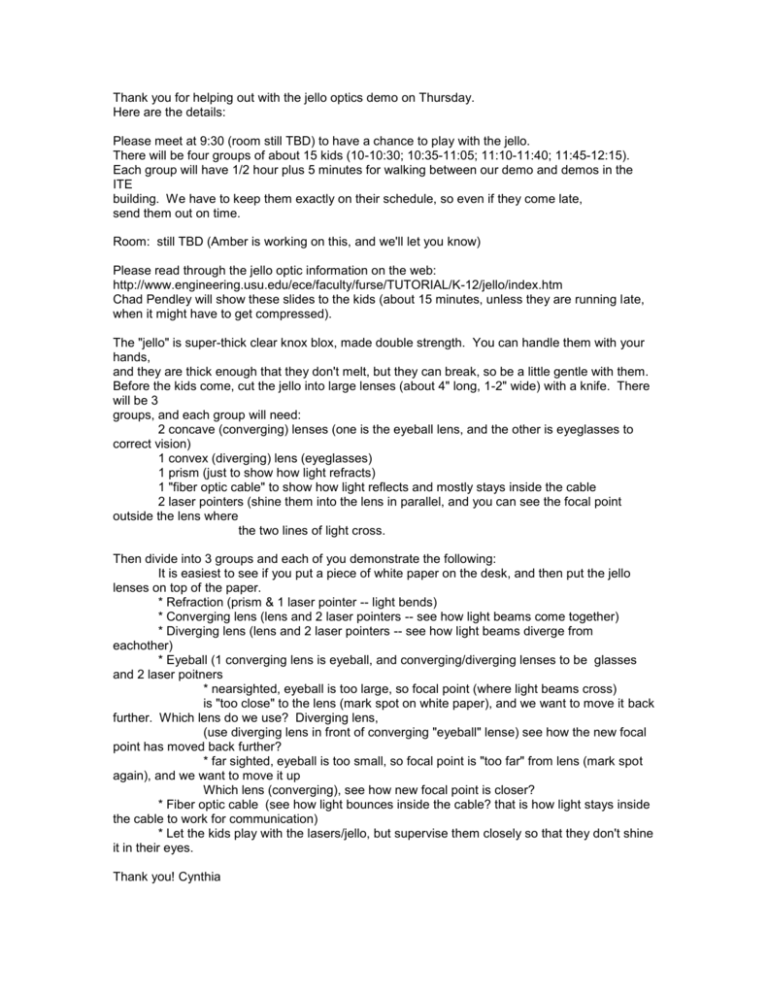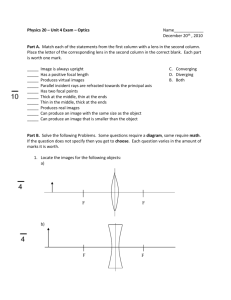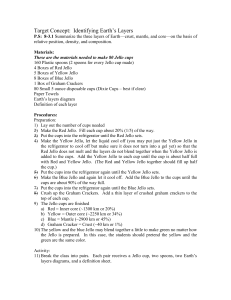Instructions
advertisement

Thank you for helping out with the jello optics demo on Thursday. Here are the details: Please meet at 9:30 (room still TBD) to have a chance to play with the jello. There will be four groups of about 15 kids (10-10:30; 10:35-11:05; 11:10-11:40; 11:45-12:15). Each group will have 1/2 hour plus 5 minutes for walking between our demo and demos in the ITE building. We have to keep them exactly on their schedule, so even if they come late, send them out on time. Room: still TBD (Amber is working on this, and we'll let you know) Please read through the jello optic information on the web: http://www.engineering.usu.edu/ece/faculty/furse/TUTORIAL/K-12/jello/index.htm Chad Pendley will show these slides to the kids (about 15 minutes, unless they are running late, when it might have to get compressed). The "jello" is super-thick clear knox blox, made double strength. You can handle them with your hands, and they are thick enough that they don't melt, but they can break, so be a little gentle with them. Before the kids come, cut the jello into large lenses (about 4" long, 1-2" wide) with a knife. There will be 3 groups, and each group will need: 2 concave (converging) lenses (one is the eyeball lens, and the other is eyeglasses to correct vision) 1 convex (diverging) lens (eyeglasses) 1 prism (just to show how light refracts) 1 "fiber optic cable" to show how light reflects and mostly stays inside the cable 2 laser pointers (shine them into the lens in parallel, and you can see the focal point outside the lens where the two lines of light cross. Then divide into 3 groups and each of you demonstrate the following: It is easiest to see if you put a piece of white paper on the desk, and then put the jello lenses on top of the paper. * Refraction (prism & 1 laser pointer -- light bends) * Converging lens (lens and 2 laser pointers -- see how light beams come together) * Diverging lens (lens and 2 laser pointers -- see how light beams diverge from eachother) * Eyeball (1 converging lens is eyeball, and converging/diverging lenses to be glasses and 2 laser poitners * nearsighted, eyeball is too large, so focal point (where light beams cross) is "too close" to the lens (mark spot on white paper), and we want to move it back further. Which lens do we use? Diverging lens, (use diverging lens in front of converging "eyeball" lense) see how the new focal point has moved back further? * far sighted, eyeball is too small, so focal point is "too far" from lens (mark spot again), and we want to move it up Which lens (converging), see how new focal point is closer? * Fiber optic cable (see how light bounces inside the cable? that is how light stays inside the cable to work for communication) * Let the kids play with the lasers/jello, but supervise them closely so that they don't shine it in their eyes. Thank you! Cynthia









